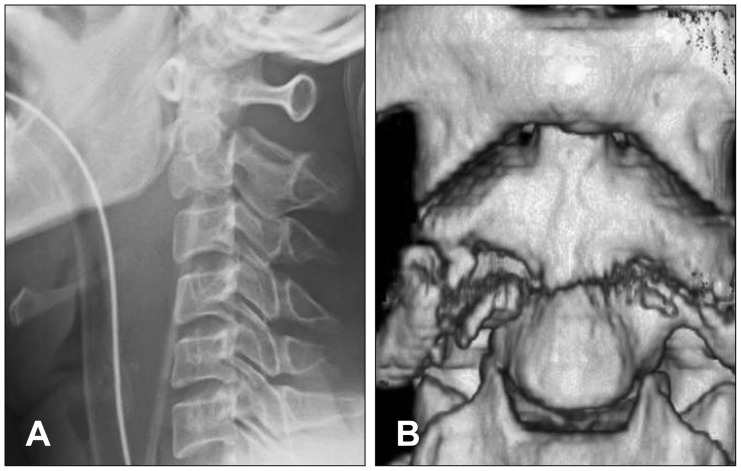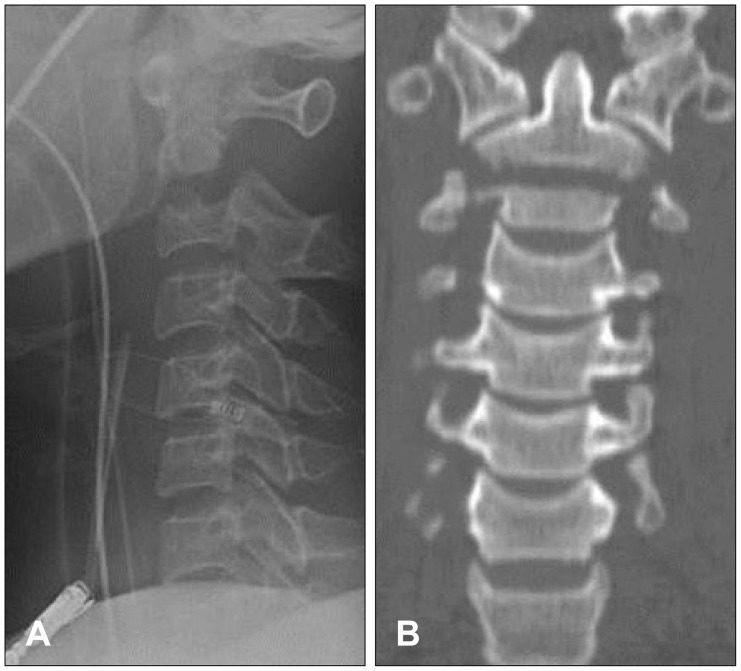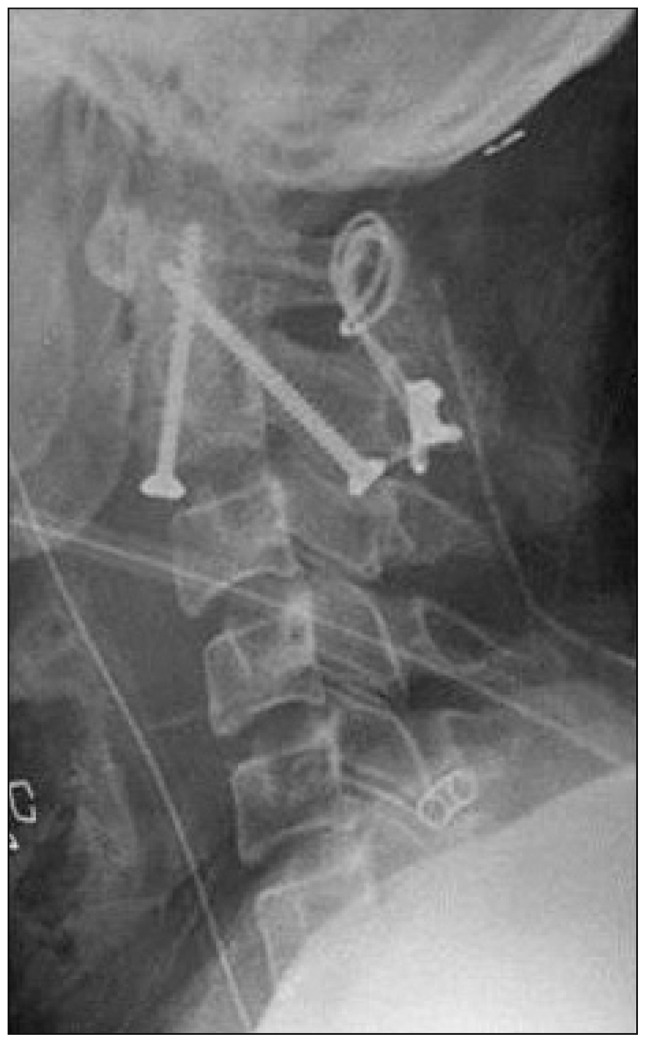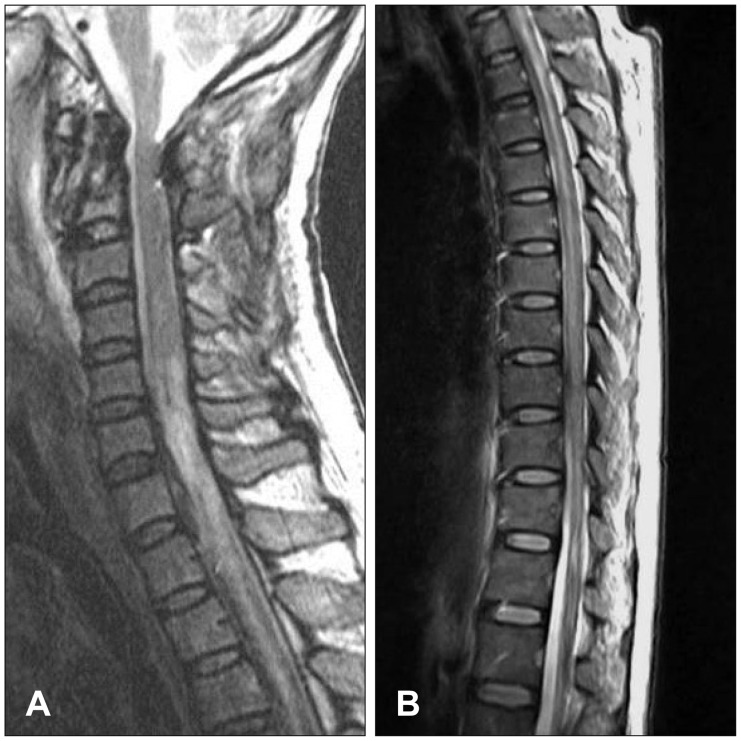Korean J Neurotrauma.
2014 Oct;10(2):149-151. 10.13004/kjnt.2014.10.2.149.
Traction Induced Vertical Displacement of Odontoid due to Type III Odontoid Fracture with Unrecognized Ligamentous Injury: A Case Report
- Affiliations
-
- 1Department of Neurosurgery, Chonnam National University Hospital, Gwangju, Korea. jkl@chonnam.ac.kr
- KMID: 2256257
- DOI: http://doi.org/10.13004/kjnt.2014.10.2.149
Abstract
- Dens fractures are a common traumatic cervical spine injury. Among them, a type III fracture is the second common fracture. Although there are several treatment options, it has been accepted that type III fracture is usually healed by non-surgical method. After adequate reduction with traction, subsequent external immobilization has been associated with successful union rates. However, in the review of literatures, there are some cases with neurological deterioration after application of skull traction. So, the authors report a case of type III dens fracture with initially unrecognized ligamentous injury in which vertical dissociation and quadriplegia occurred after only five-pound Gardner-Well tongs traction. And also, the authors raise awareness of this potentially injury.
Figure
Reference
-
1. Adams VI. Neck injuries: II. Atlantoaxial dislocation--a pathologic study of 14 traffic fatalities. J Forensic Sci. 1992; 37:565–573. PMID: 1500898.
Article2. Coast GC, Gee DJ. Traumatic subarachnoid haemorrhage: an alternative source. J Clin Pathol. 1984; 37:1245–1248. PMID: 6501587.
Article3. Contostavlos DL. Massive subarachnoid hemorrhage due to laceration of the vertebral artery associated with fracture of the transverse process of the atlas. J Forensic Sci. 1971; 16:40–56. PMID: 5555585.4. Fairholm D, Lee ST, Lui TN. Fractured odontoid: the management of delayed neurological symptoms. Neurosurgery. 1996; 38:38–43. PMID: 8747949.
Article5. Hammer AJ. Lower cranial nerve palsies. Potentially lethal in association with upper cervical fracture-dislocations. Clin Orthop Relat Res. 1991; 64–69. PMID: 2019070.
Article6. Kirkpatrick JS, Sheils T, Theiss SM. Type-III dens fracture with distraction: an unstable injury. A report of three cases. J Bone Joint Surg Am. 2004; 86-A:2514–2518. PMID: 15523027.
Article7. Lindenberg R, Freytag E. Brainstem lesions characteristic of traumatic hyperextension of the head. Arch Pathol. 1970; 90:509–515. PMID: 5485108.8. Pryputniewicz DM, Hadley MN. Axis fractures. Neurosurgery. 2010; 66(3 Suppl):68–82. PMID: 20173530.
Article9. Przybylski GJ, Welch WC. Longitudinal atlantoaxial dislocation with type III odontoid fracture. Case report and review of the literature. J Neurosurg. 1996; 84:666–670. PMID: 8613861.10. Robertson PA, Ryan MD. Neurological deterioration after reduction of cervical subluxation. Mechanical compression by disc tissue. J Bone Joint Surg Br. 1992; 74:224–227. PMID: 1544957.
Article
- Full Text Links
- Actions
-
Cited
- CITED
-
- Close
- Share
- Similar articles
-
- Anterior Screw Fixation of Anteriorly Displaced Type III Odontoid Fracture Corrected by Transoral Digital Manipulation
- A Case of Pediatric Odontoid Base Fracture Treated by Halovest Fixation
- Outcomes of Patients Undergoing Anterior Screw Fixation for Odontoid Fracture and Analysis of the Predictive Factors for Surgical Failure
- Strategies for Anterior Screw Fixation for Type II Odontoid Process Fracture, and Long-Term Follow-up Results
- Clinical Review of the Isolated Acute Axis Fracture





